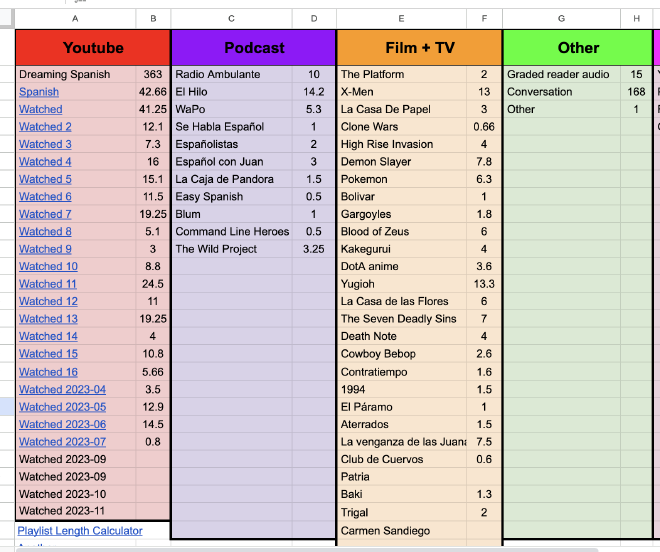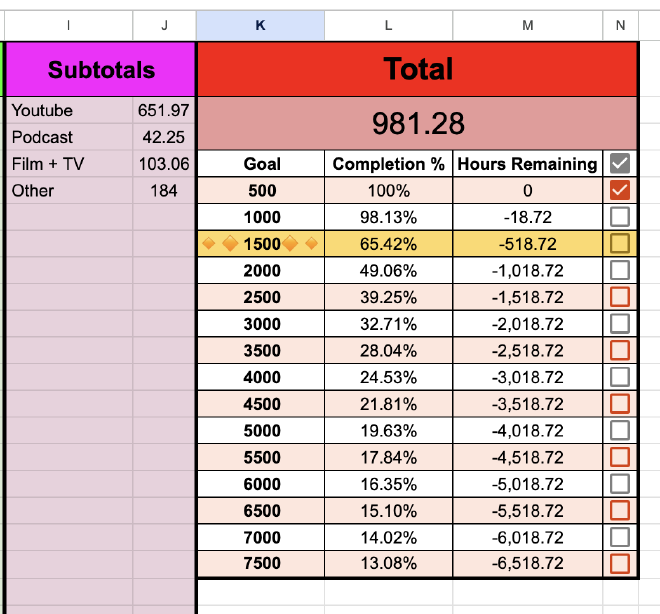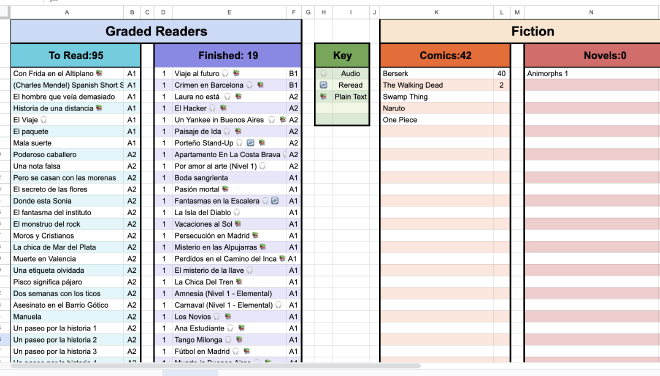My Language Immersion Tracker
Table of Contents
One of the best pieces of advice I’ve ever received comes from weight training. It goes as follows:
What gets measured, gets managed. #
Imagine walking into a gym with no plan, no records, and no method of writing down what you did. You don’t know what exercises to do or what order they should be done in, so you just wander around, pulling cables here, shoulder pressing dumbells there, whatever strikes your fancy at any given moment. You don’t know what weight you’ve lifted in the past, so you just lift whatever feels right and just stop lifting whenever you get tired or bored.
I’m sure doing that is better than doing nothing, but exercising like that will get you nowhere fast. If nothing is measured, then nothing can be improved. If you don’t know how far you’ve come, then you don’t know how far you need to go. The most important thing your can bring to a gym besides their water bottle is a notebook. If you can see how much you’ve lifted in the past, it’s easy to see when your progress is stalling and correct it. If you’ve recorded your limits in the past, you’ll know when it’s time to push beyond the boredom and when it’s time to call it quits for the day. Conscious monitoring is always more useful than vibes.
Language learning is very similar. The number one mistake my students make is underestimating how much time needs to be invested in learning a language. Languages can’t be acquired in a few months or a hundred hours. A language isn’t a technical skill, like computer programming or painting. Learning a language requires thousands of hours of regular and meaningful direct exposure to the language itself.
That’s why, several years ago, I came up with a spreadsheet to track my progress in the languages I’ve attempted to learn. I did this first with Latin, but I’ve used my Spanish tracker the most over the past few years. Let’s take a look:
My Immersion Tracker #

This is where I track all the hours I’ve spent watching and listening to Spanish. The numbers represent hours and portions of an hour (e.g. 24.5 means twenty-four hours and thirty minutes, and 10.8 represents ten hours and forty-eight minutes).
The Podcast and Film + TV fields are more or less self-explanatory, but the Youtube column is a little more complicated. Dreaming Spanish refers to the hours I spent on their platform, which I highly recommend to anyone learning Spanish. Each playlist below with ‘Watched’ in the title represents one month. Each month, I add the videos I watched in Spanish to that month’s playlist, then use the playlist calculators at the bottom of the column to determine how much time that is. I start a new playlist each month so that deleted videos are less likely to subtract from my overall count.
The Other field is how I add in things that don’t fit neatly into the other three columns, such as conversations and audio from graded readers.
This takes us to the final two columns of the sheet:

All four fields are subtotaled, then totaled again in K2:N3 to display my current total of immersion hours. Below that, I track how far I am from my various sub-goals both in terms of percentage and number of hours. My real goal is 1,500 hours, as I’ve heard from various sources that this is how many hours of immersion are required to get an English speaker to a roughly C1 level, so all the numbers listed below are more for my amusement at this point. If I were learning a more difficult language for English speakers, such as Japanese or Arabic, I’d at least double my goal to 3,000 hours.
There’s also another sheet that documents my reading:

I don’t use this nearly as much as the first sheet, but I plan to change that in the near future as I add more reading into my immersion. I’m fortunate enough have access to a large number of graded readers, so I’ve arranged them in what’s theoretically the best reading order. I also notate which readers have audio, which readers are in plain text (and easily mined for sentences), and which readers I feel were a bit difficult and need re-reading. To the right, I’ve also listed the native-speaker material that I’ve read, including comics and books. I plan to start out with children’s books and work my way up to more adult material.
So what’s the point? #
None of this is nearly as complicated as it looks; once the functions and formulas are set up, I don’t need to add anything else except the names and numbers, which takes literally less than thirty seconds a day.
In exchange, I now have an accurate map of my progress in Spanish. I know where I’ve been and how far I need to go. I never throw up my hands in exasperation and bemoan my lack of progress. After all, it’s kind of pointless to get frustrated if I’ve immersed in the language for only 200 hours (or 400, or 600, and so on). As of today, I’ve immersed in Spanish for 981.28 hours, meaning I’ve completed 65.42% of my journey. I know exactly where I am and I know exactly where I’m going. Do you?
If you’d like a free and empty copy of my spreadsheet to help you on your language learning journey, you can find it here. Simply click File > Make a Copy.